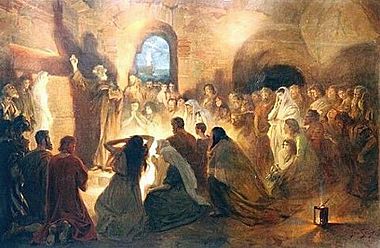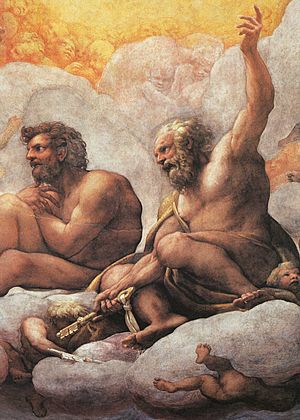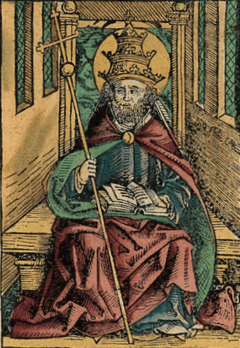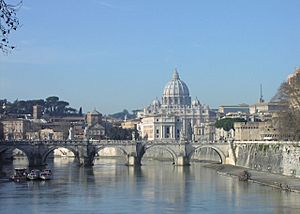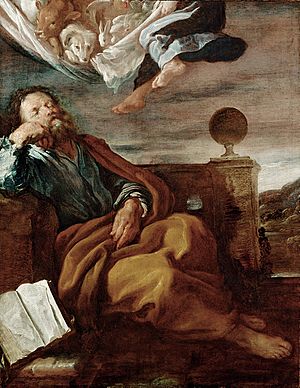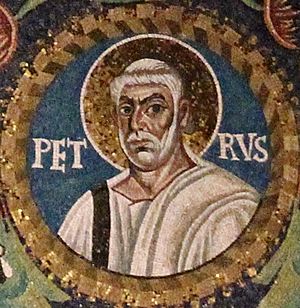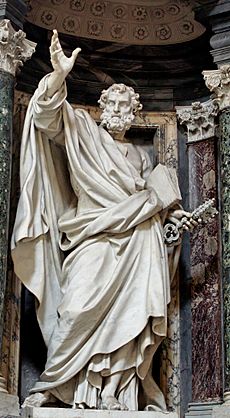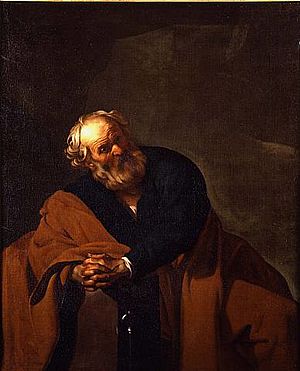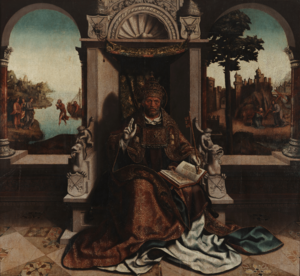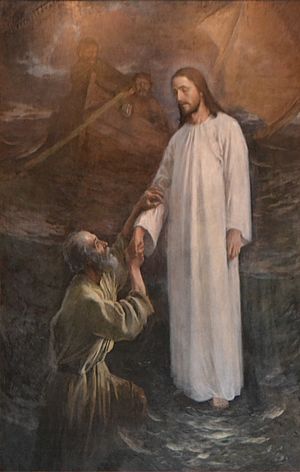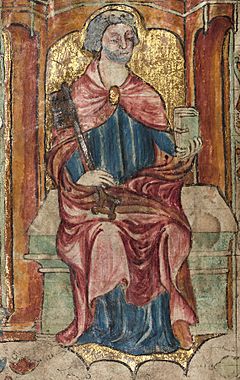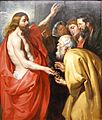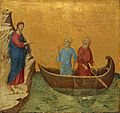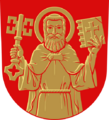Saint Peter facts for kids
Quick facts for kids Saint Peter the Apostle |
|
|---|---|
|
|

Saint Peter (c. 1610–1612) by Peter Paul Rubens, showing Peter holding the Keys of Heaven.
|
|
| Church | Early Christian |
| See |
|
| Papacy began | AD 30 |
| Papacy ended | Between AD 64–68 |
| Successor |
|
| Personal details | |
| Birth name | Shimon Bar Yonah (Hebrew: שמעון בר יונה) (Simeon, Simon) |
| Born | c. AD 1 Bethsaida, Gaulanitis, Syria, Roman Empire |
| Died | Between AD 64–68 probably Vatican Hill, Rome, Italia, Roman Empire |
| Parents | John (or Jonah; Jona) |
| Occupation | Fisherman, clergyman |
| Sainthood | |
| Feast day |
|
| Venerated in | All Christian denominations that venerate saints and in Islam |
| Canonized | Pre-Congregation |
| Attributes | Keys of Heaven, Red Martyr, pallium, papal vestments, man crucified upside down, vested as an Apostle, holding a book or scroll, Cross of Saint Peter |
| Patronage | Patronage list |
| Shrines | St. Peter's Basilica |
Saint Peter (died between AD 64 and 68) was a very important leader in the early Christian Church. He was one of the Twelve Apostles of Jesus Christ. People also know him as Peter the Apostle, Simon Peter, Simeon, Simon, or Cephas. The name Cephas means 'rock'.
Christian tradition says Peter was crucified in Rome under Emperor Nero. Many old Christian churches honor Peter as a major saint. They see him as the founder of the Church of Antioch and the Church of Rome. Different churches have different ideas about the authority of his successors. The Catholic Church believes Jesus gave Peter a special role in the Church.
The New Testament mentions "Simon Peter" 19 times. He appears often in all four gospels and the Acts of the Apostles. Peter was the brother of Saint Andrew, and both were fishermen. The Gospel of Mark is thought to have been influenced by Peter's stories. Peter or Cephas is also mentioned in Paul's letters. Two letters in the New Testament, First Peter and Second Peter, are traditionally said to be written by him.
Catholic and Orthodox traditions say Peter was the first bishop of Rome (or pope). He was also the first bishop of Antioch. Historians believe he served as pope from AD 30 until his death. This would make him the longest-serving pope.
Contents
Peter's Names and Meanings
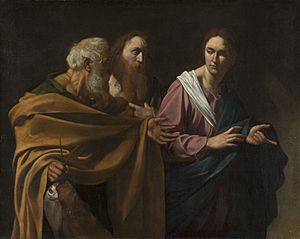
The New Testament says Peter's first name was Simon. In some parts, it is spelled "Simeon." This might be because Jewish people often gave their children a name from the Old Testament (like Simeon) and a similar-sounding Greek or Roman name (like Simon).
Later, Jesus gave him the name Cephas. This comes from the Aramaic word for "rock" or "stone." In English Bibles, this name is usually translated as Peter. The Greek word for Peter, Petros, also means "rock" or "stone."
The exact meaning of the Aramaic word Cephas has been discussed. Some say it means "rock" or "crag," while others say it means "stone," like a "jewel." Most scholars agree that as a name, it suggests a strong or tough character.
The name "Simon Peter" appears 19 times in the New Testament.
Peter's Life Story

We learn about Peter's life from a few main sources. These include the New Testament writings like the Gospels and the Acts of the Apostles. We also learn from writings by early Church leaders.
Peter was a Jewish fisherman from Bethsaida. His father's name was Jonah or John. The Gospels tell us that Jesus healed Peter's mother-in-law at their home in Capernaum. This shows Peter was married or a widower.
In the Gospels, Peter was a fisherman with his brother, Andrew, and the brothers James and John. Jesus called Simon and Andrew to be "fishers of men."
In a famous moment, Peter said that Jesus was the Christ (the Jewish Messiah). This happened near Caesarea Philippi. There, Jesus gave him the name Cephas, or Peter.
In the Gospel of Luke, Jesus uses Peter's boat to preach to many people by the Sea of Galilee. Jesus then tells Peter and his friends to lower their nets, and they catch a huge number of fish. After this, they follow Jesus.
The Gospels of Matthew, Mark, and John tell the story of Jesus walking on water. Matthew's Gospel also describes Peter walking on water for a moment. But he starts to sink when his faith becomes weak.
At the Last Supper, Jesus washed his disciples' feet. Peter first refused, but when Jesus said he must, Peter agreed.
When Jesus was arrested, one of his friends cut off the ear of a servant of the High Priest. The Gospel of John says Peter was the one who used the sword. Luke adds that Jesus touched the ear and healed it.
Peter and John were later brought before the Sanhedrin (a Jewish court). They bravely spoke out for Jesus. Peter also had a vision from God. This vision helped him understand that God wanted the good news to be shared with non-Jewish people (called Gentiles).
Peter and John were sent from Jerusalem to Samaria. Peter is also mentioned in Paul's letter to the Galatians. Paul says he met Peter in Jerusalem. Later, Paul disagreed with Peter in Antioch about how Jewish and non-Jewish Christians should eat together.
The book of Acts tells how Peter was put in prison in Jerusalem. But an angel helped him escape. After this, Peter left Jerusalem.
Peter: A Key Leader in the Early Church
The Gospels and Acts show Peter as a very important apostle. He was the first disciple to whom Jesus appeared after his resurrection. This helped Peter regain his place after he denied Jesus three times. Peter is seen as the first leader of the early Church. He is called "the rock" on which the church would be built.
Peter's Place Among the Apostles
Peter is always listed first among the Twelve Apostles in the Gospels and the Book of Acts. He, along with James and John, formed a special group within the Twelve. Jesus allowed only them to be present at three important times: the Raising of Jairus' daughter, the Transfiguration of Jesus, and the Garden of Gethsemane. Peter often spoke for all the Apostles and showed his strong belief in Jesus.
The author of the Acts of the Apostles shows Peter as a central figure in the early Christian community. Peter gave an important sermon at Pentecost. He also led the choice of a new apostle to replace Judas Iscariot. Peter also helped those in need, healing the sick and raising people from the dead. These actions helped more people believe in the early Church.
Peter Denies Jesus
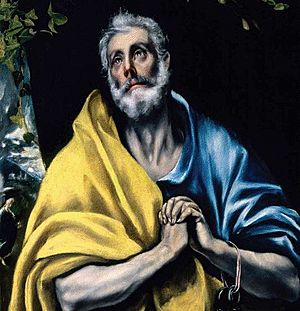
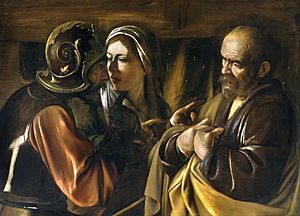
All four Gospels tell how Jesus predicted that Peter would deny him three times before a rooster crowed. This happened during Jesus' arrest and trial.
- First, a servant girl said Peter had been with Jesus.
- Second, another person said he was a follower of Jesus.
- Third, Peter's accent gave him away as being from Galilee.
After each denial, a rooster crowed. In the Gospel of Luke, Jesus tells Peter, "I have prayed for you, that your faith may not fail." Later, after Jesus' resurrection, Peter tells Jesus three times that he loves him. This balances his three denials.
Jesus Appears After His Resurrection

Paul's First Letter to the Corinthians says that Jesus appeared to Peter first after his resurrection. This shows Peter was the first to see the risen Christ.
In John's Gospel, Peter is the first person to enter the empty tomb, though women and another disciple saw it before him. In Luke's story, Peter runs to the tomb after hearing the women's report. He sees the grave clothes and goes home.
In the last chapter of John's Gospel, Jesus appears to Peter again. Peter says three times that he loves Jesus, and Jesus confirms Peter's important role. The Church of the Primacy of St. Peter on the Sea of Galilee is believed to be where this happened.
Peter as a Leader
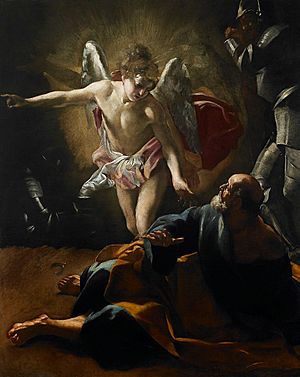
Peter, along with James and John, was seen as a "pillar" of the Church. He took on leadership among Jesus' early followers. Paul said that Peter had a special job as an apostle to the Jews, just as Paul was an apostle to the non-Jews.
The "Rock" Conversation
In a talk between Jesus and his disciples, Jesus asks, "Who do people say that the Son of Man is?" Peter answers, "You are the Messiah, the Son of the living God."
Jesus then says to Peter: "I also say to you now that you are Peter, and on this rock I will build my Church, and the gates of Hades will not prevail against it."
This passage is very important. Many Christians believe Jesus meant that Peter himself was the "rock" on which the Church would be built. They see Peter as a symbol of strength and stability for the Church. Other Christians believe the "rock" refers to Peter's strong faith in Jesus, not Peter himself.
The name Petros (Peter) was not a common name before this. But after Peter's important role in the early Church, it became a popular Christian name.
Apostolic Succession
The idea of Peter's leadership is the basis for "Apostolic succession." This is the belief that the authority of the apostles, especially Peter, has been passed down through a line of bishops.
Catholics see Peter as the chief of the Apostles. Eastern Orthodox and Oriental Orthodox churches also call him "Preeminent Apostle." This means he was very important among the Apostles.
Peter in Antioch and Corinth
Antioch
The Bible says Peter went to Antioch. There, Paul openly disagreed with him about how Jewish and non-Jewish Christians should eat together. Later traditions say Peter was the first leader (Patriarch) of the church in Antioch. Some writings say Peter served as bishop of Antioch for seven years.
Corinth
Peter may have also visited Corinth, a city in Greece. The First Letter to the Corinthians suggests that Peter might have visited the city during his missionary travels.
Peter's Connection to Rome
Early Christian tradition says that Peter helped found the Church in Rome with Paul. It also says he served as its bishop and was killed there.
The Papacy
The Catholic Church believes the pope, the bishop of Rome, is the successor of Saint Peter. This means they see Peter as the first Bishop of Rome. However, Peter himself never used the title "Pope."
Early Church writings, like Against Heresies (around AD 180), say that Linus was Peter's successor. He is recognized as the second Bishop of Rome by the Catholic Church.
Peter's Arrival in Rome
New Testament Mentions
The Bible does not clearly say that Peter was ever in Rome. However, the First Letter of Peter mentions "The church that is at Babylon." Some believe "Babylon" was a secret name for Rome at that time.
Paul's letter to the Romans, written around AD 57, greets many people in Rome. But it does not mention Peter, whom Paul knew. Also, the book of Acts does not mention Peter being in Rome during Paul's two-year stay there.
Early Church Writers
Writers from the early Church, like Ignatius of Antioch (around AD 100), mention Peter and Paul giving advice to the Romans. This suggests Peter was in Rome.
Irenaeus of Lyons (around AD 130-202) wrote that Peter and Paul founded the Church in Rome. They also appointed Linus as the next bishop.
Clement of Alexandria (around AD 150-215) said that Peter preached in Rome. Origen (around AD 184-253) and Eusebius also wrote that Peter went to Rome after founding the church in Antioch. He then led the church in Rome until his death.
Simon Magus
Some early writers tell a story about Peter facing a magician named Simon Magus. They say Simon Magus fled to Rome, and Peter followed him there. In Rome, Peter defeated Simon Magus.
Jerome (AD 327-420) wrote that Peter went to Rome to challenge Simon Magus. He said Peter held the leadership position there for 25 years until Nero's time.
Peter's Death and Burial
Crucifixion in Rome
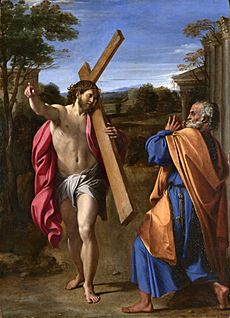
In the Gospel of John, Jesus hints at Peter's death. He says, "when you are old you will stretch out your hands, and another will dress you and carry you where you do not want to go." Many believe this means Peter would die by crucifixion.
Early Church tradition says Peter was crucified around AD 64, during Emperor Nero's rule. This was likely after the Great Fire of Rome, for which Nero blamed Christians. Tradition says Peter was crucified upside down on Vatican Hill. He felt he was not worthy to die in the same way as Jesus.

Pope Clement I (died AD 99) wrote about Peter's death. He said Peter "endured not one or two but many labours, and at last, having delivered his testimony, departed unto the place of glory due to him."
A story from the 2nd century, called the Acts of Peter, tells about "Quo vadis, Domine?" (meaning "Where are you going, Lord?"). In the story, Peter is fleeing Rome to avoid being killed. He meets Jesus and asks, "Quo vadis?" Jesus replies, "I am going to Rome to be crucified again." Peter then bravely returns to Rome and is killed.
Many early Christian writers, like Tertullian and Origen, confirm that Peter was crucified in Rome. Origen specifically states that Peter was crucified upside down, as he had wished.
Peter's Burial Place
Catholic tradition says Peter was buried near where he was crucified, in Nero's gardens. This is the site of Saint Peter's tomb.
In the early 300s, Emperor Constantine I decided to build a large church to honor Peter. This church, St. Peter's Basilica, was built directly over what was believed to be Peter's burial site. The main altar of the Basilica is still located over this spot.
Peter's Relics
In 1950, human bones were found under the altar of St. Peter's Basilica. Many believe these are Peter's bones. In 1968, Pope Paul VI announced that these bones were most likely the relics of Peter.
In 2013, Pope Francis showed some of these bone fragments to the public for the first time. In 2019, he gave nine of these fragments to the leader of the Eastern Orthodox Church, Bartholomew of Constantinople. This was a sign of friendship between the two churches. Most of Peter's remains are still kept in Rome, under the main altar of St. Peter's Basilica.
Peter's Letters: Rome as Babylon
Church tradition says the letters First Peter and Second Peter were written by Peter. First Peter says the author is in "Babylon." Many believe "Babylon" is a secret name for Rome. If this is true, it is the only Bible verse that suggests Peter was in Rome.
Some scholars believe Peter did not write these letters. They point out that Peter was a fisherman and might not have been able to write such complex letters.
Peter's Feast Days
The feast day for both Peter and Paul is June 29. This day celebrates their martyrdom. Augustine of Hippo said that even though they died on different days, they are celebrated together because they were united in their faith.
The Eastern Orthodox Church also celebrates Peter and Paul on June 29. This is a very important day, and it is preceded by a time of fasting.
Peter's Special Role
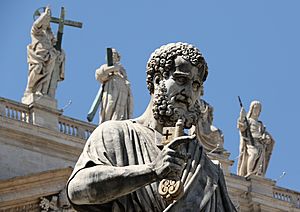
Christians have different ideas about how important Peter's role was.
- Catholics believe Peter was the first pope. They see his role, given by Jesus, as the basis for the pope's authority over the Church.
- Eastern Orthodox Christians also believe Peter had a special role. But they see it as a "primacy of honor," meaning he was respected first, but did not have power over other Church leaders.
- Protestant churches believe Peter was an important apostle, but they do not connect his work in Rome to the idea of the papacy.
Catholic Church's View
According to Catholic belief, Jesus chose Simon Peter for a special place of honor and authority. They believe Peter was the first Bishop of Rome and therefore the first Pope. They also believe every Pope is Peter's successor.
The Catholic Church bases this belief on two passages from the Gospels and on its long-standing traditions.
John 21:15–17
In this passage, Jesus tells Peter three times to "Feed my lambs" and "Tend my sheep." Catholics see this as Jesus giving Peter the job of looking after all his followers and the whole Church.
Matthew 16:18
Jesus says to Peter: "I also say to you now that you are Peter, and on this rock I will build my Church, and the gates of Hades will not prevail against it."
Catholics believe this means Peter himself is the "rock" on which Jesus would build his Church.
Paul's Letters
Paul's letter to the Romans, written around AD 57, greets many people in Rome but does not mention Peter. Also, Peter is not mentioned in Acts 28 during Paul's two-year stay in Rome. Some historians believe Peter and Paul were killed under Nero's rule around AD 64 or 68.
Protestant Views
Many Protestant Christians disagree with the Catholic view that Peter started a line of popes. Some scholars argue that the Greek words used for "Peter" (Petros) and "rock" (petra) have different meanings. They say Jesus was referring to Peter's faith as the rock, not Peter himself.
However, other scholars point out that in the language spoken at the time (Koine Greek), these words could mean the same thing. They also say that in Aramaic, the word Kepha means "rock" and was the name Jesus gave Peter.
Some Protestant scholars believe Jesus did mean Peter was the rock, but that this does not mean there should be a line of successors to Peter's position.
Eastern Orthodox View
The Eastern Orthodox Church sees Peter and Paul as "Preeminent Apostles." Peter is also called Coryphaeus, meaning "Choir-director" or lead singer. They recognize Peter's leadership in the very early Church in Jerusalem. But they do not believe he had a "princely" role over the other Apostles.
The Orthodox Church does not believe the New Testament supports Peter having special authority over faith or morals. They also believe Peter did not act as the main leader at the Council of Jerusalem.
The Orthodox Church does not see the Bishop of Rome as Peter's successor in the same way Catholics do. They believe that when Jesus said, "You are Peter and upon this rock I will build my church," he was talking about Peter's confession of faith, not Peter as a person.
Syriac Orthodox Church View
The Syriac Orthodox Church believes Peter had a unique role in the early Christian community. They see "rock" (Kepha) as a name for Jesus. When Jesus gave his name "Kepha" to Simon, he was sharing his role with Peter. They believe Jesus made Simon the chief shepherd in his place.
New Apostolic Church View
The New Apostolic Church believes Peter was the first Chief Apostle.
The Church of Jesus Christ of Latter-day Saints View
The Church of Jesus Christ of Latter-day Saints teaches that Peter was the first leader of the early Christian church after Jesus' death and resurrection. They believe Peter appeared to their founder, Joseph Smith, to give him the authority of the apostles. They interpret the "rock" Jesus spoke of as the "rock of revelation."
Non-Christian Views
Judaism
Some Jewish traditions say that Peter joined early Christians to help them form their own distinct religion. This was to prevent people from confusing Christianity with Judaism. Despite this, he was said to remain a practicing Jew.
Islam
Muslims see Jesus as a prophet of God. The Quran mentions Jesus's disciples but does not name them. However, Muslim writings often name Peter among them. An old story says Peter was one of three disciples sent to Antioch to preach.
Twelver Shia Muslims see a similarity between Peter and Ali (a key figure in Islam). They see Ali as a leader after Muhammad, just as they see Peter as a leader after Jesus.
Baháʼí Faith
In the Baháʼí Faith, Peter's special role as "The Rock" is supported. They believe Peter's faith in Christ as the Son of God became the foundation for Christianity.
Ossetian Mythology
In Ossetian mythology, Peter's name is linked to Donbettyr, the god of waters and patron of fishermen.
Andean Traditional Medicine
The San Pedro cactus is used in Andean traditional medicine. Its name, "San Pedro cactus" (Saint Peter cactus), comes from the belief that it helps users "reach heaven while still on earth," just as St. Peter holds the keys to heaven.
Peter's Writings
Traditionally, two letters in the Bible, 1 Peter and 2 Peter, are believed to be written by Peter. Several other ancient writings are also linked to him.
Peter in Art
The earliest known picture of Peter is from the 4th century. In art, Peter is usually shown as an older man with a short beard and white hair, sometimes balding. He often holds one or two large keys, which became his symbol in the 8th century. This symbol is still used today.
Peter is often shown near Jesus in Bible stories. For example, in pictures of Jesus' arrest, Peter is often shown cutting off the soldier's ear. Other scenes show his crucifixion, his rescue from prison, or his trial. In later art, scenes of Peter denying Jesus became popular.
Patronage
| Workers | ||
|---|---|---|
|
|
|
| Called for aid in | ||
|
||
| Institutions | ||
|
|
|
| Churches and Cathedrals | ||
| Locations | ||
|
|
|
Images for kids
-
Saint Peter Attempting to Walk on Water, by François Boucher, 1766
-
The Release of St. Peter by Bernardo Strozzi, 1635
-
Jesus gives Peter the keys to Heaven by Peter Paul Rubens, 1614
-
Peter Enthroned, by Arnolfo di Cambio (13th-century statue in St Peter's Basilica, Rome)
-
The Miraculous Draught of Fishes, by Raphael, 1515
-
Jesus calling Simon Peter and Andrew by Duccio di Buoninsegna, 1308–1311
-
Alessandro Turchi, Saint Agatha Attended by Saint Peter and an Angel in Prison, 1640–1645
-
Fresco by Pietro Perugino in the Sistine Chapel, 1480–1482
-
Statue of Saint Peter (c. 1510–1520) at the V&A
See also
 In Spanish: Simón Pedro para niños
In Spanish: Simón Pedro para niños
- List of Catholic saints
- List of popes
- Saint Peter and Islam
- Saint Peter and Judaism
- Saint Peter's Square
- Saint Peter's tomb
- St. Peter's Basilica
- Sword of Saint Peter




